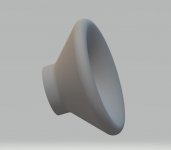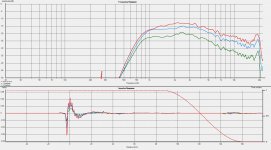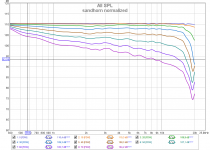It looks good - if it is as thick as it looks, you already have a rollback of sort.
What is the program you use to measure? Nice that distance and gating is indicated in the impulse!
//
What is the program you use to measure? Nice that distance and gating is indicated in the impulse!
//
It is a waste of time if comparing horns is what you want to do. It's not a total waste of time as it can reveal possible serious flaws in the system
Detailed anechoic response including the radiation pattern is the downright essential requirement for any serious loudspeaker design. It's quite a shame we have to even discuss it here.
You have not read my post good enough, I wrote compare/measure two horns in the listening spot. I have never claimed that a speaker should be developed in the room. (Even if I and many others do it just for fun)
My point is also like wesayso, that most rooms will muck it up in the end! That is a shame that we have to discuss here😉
Here is a measurement of an axisymmetric horn I printed yesterday.
not so easily printable.
Just out of curiosity, what was the highpass on the compression driver?
If you can turn wood, you maybe able to fabricate this horn without having to print it. It just needs a blade edge with the shape of your waveguide profile, obtainable using a laser cut. The rollback could be joined later.
Last edited:
Holm Impulse 🙂
Super simple and effective!
HOLM Acoustics
I believe a thin rolled back wall tackles the back waves better than a thick round wall.
I think Mabat did a bit of a study of it a couple of hundred of pages back 😀
Super simple and effective!
HOLM Acoustics
I believe a thin rolled back wall tackles the back waves better than a thick round wall.
I think Mabat did a bit of a study of it a couple of hundred of pages back 😀
It looks good - if it is as thick as it looks, you already have a rollback of sort.
What is the program you use to measure? Nice that distance and gating is indicated in the impulse!
//
No, they won't. That's the point you are still missing.My point is also like wesayso, that most rooms will muck it up in the end! That is a shame that we have to discuss here😉
200hz high pass
I'm sticking with 3d printing for the time being, before I move on to casting.
I'm sticking with 3d printing for the time being, before I move on to casting.
Just out of curiosity, what was the highpass on the compression driver?
If you can turn wood, you maybe able to fabricate this horn without having to print it. It just needs a blade edge with the shape of your waveguide profile, obtainable using a laser cut. The rollback could be joined later.
That's exceptionally well behaved in the top octave - must be the driver.Here is a measurement of an axisymmetric horn I printed yesterday.
It has a diameter of 342mm and is 163mm long on axis.
Measured with BMS4550
There are still things to improve in the midrange but you are definitely on the right track.


It's always a pleasure to see such good results.
Last edited:
Care to show an example?I can very well envision a WG designed for a specific location and with a certain behaviour that compared to, say, the small sand horn, freestanding, would seem less ideal but in the end, in the intended room integrated into the system, would perform better than said sand horn - in the listening position.
We design for a flat and smooth direct sound response at the listening position, as well as for flat and smooth spectra of all the reflections reaching the listening position just after the direct sound. That's what we do. We can also eliminate the negative effects of the very early reflections by making the speakers high DI and aim them accordingly.I suppose we design for the listening position as anything else would be just technical show off.
Last edited:
I personally don't like designing for a particular room in mind...I focus on nearfield ability...but that is my personal preference... does it not seem that a controlled dispersion or a narrow dispersion wins in any room? The controlling and narrowing of the beamwidth is one step closer to removing the room (ie lowering indirect energy)...which is exactly what horns and waveguides benefit from (increased directivity) the more narrow the beam width the less the indirect energy, the increase in perceived resolution...waveguides attempt to finesse this process and provide constant beamwidth for the majority of their passband where as traditional horns have narrow directivity in the hf and it widens as the frequency lowers...both still with more directivity than a tweeter without a horn/waveguide....
Potentially a constant directivity horn or waveguide is presenting a larger amount of neutral energy as whole...where as traditional horns are providing more of a tilted frequency into the indirect energy field...yet high directivity up top....
One limiting the size of the sweet spot but having higher HF resolution in the sweet spot due to less indirect energy in the room ....
The other having a wider sweet spot and higher resolution off axis due to the increase amount of neutral off axis energy
one allowing the tweeter to play as low as 400hz in some cases....the other only till about 900hz...unless you are using something like the axi2050 or a radian950 (2" exit large 4" diaphragm) or one of the other compression drivers rated to 300hz......in these case it has not been explored to what depth of frequency, a practical waveguide can be used in home use (that I've seen that is)....
Rather horn or waveguide, each loose directivity based on the width of the horn....
cardioid action is a form of acoustical waveguide, in a sense....
Since waveguide+drivers don't need enclosures (or damping material), why not use them for active cardioid? I guess that doesn't make sense...the Dutch 8c is an example of what can be done....and a compression driver cannot play low enough (in a waveguide) to make this relevant....
can I used ATH to design dispersion slots?
Potentially a constant directivity horn or waveguide is presenting a larger amount of neutral energy as whole...where as traditional horns are providing more of a tilted frequency into the indirect energy field...yet high directivity up top....
One limiting the size of the sweet spot but having higher HF resolution in the sweet spot due to less indirect energy in the room ....
The other having a wider sweet spot and higher resolution off axis due to the increase amount of neutral off axis energy
one allowing the tweeter to play as low as 400hz in some cases....the other only till about 900hz...unless you are using something like the axi2050 or a radian950 (2" exit large 4" diaphragm) or one of the other compression drivers rated to 300hz......in these case it has not been explored to what depth of frequency, a practical waveguide can be used in home use (that I've seen that is)....
Rather horn or waveguide, each loose directivity based on the width of the horn....
cardioid action is a form of acoustical waveguide, in a sense....
Since waveguide+drivers don't need enclosures (or damping material), why not use them for active cardioid? I guess that doesn't make sense...the Dutch 8c is an example of what can be done....and a compression driver cannot play low enough (in a waveguide) to make this relevant....
can I used ATH to design dispersion slots?
Last edited:
Care to show an example?
....
Say a WG that is 6 dB down at 45 deg intended to sit tight into a corner for a flat summation via the +6 dB wall contribution.
//
"Design for a room" is an utter nonsense in the first place. We can hear "through" the room quite easily as long as the room is not a total disaster. The better the speakers alone the better the sound in the room. It's as easy as that.
Last edited:
Here is a measurement of an axisymmetric horn I printed yesterday.
It has a diameter of 342mm and is 163mm long on axis.
Measured with BMS4550
View attachment 934965
View attachment 934964
So in a way - yea, the OS-SE contour works!
And it might even be better with a foldback, but that is not so easily printable.
The impulse does not look ideal.
I would love to have a 3D printer that prints so large. Used to just send it out for milling a prototype
Say a WG that is 6 dB down at 45 deg intended to sit tight into a corner for a flat summation via the +6 dB wall contribution.
//
That is just the polar patter / dispersion / how'd you call it, -6db at 45 degrees off-axis is practically a 90 degree waveguide. You can design for any polar pattern you want.
Constant directivity means the frequency response is there at 45 degrees off-axis pretty much the same as on-axis, just 6db down if it was the nominal 90 degree polar pattern. Non constant directivity horn might have -6db there at 45 degree off-axis only at some single frequency say 3kHz, maybe -12db at 10kHz, +2dB at 4kHz due to some weird diffraction, might be a bumpy road. Good quality waveguide has the same frequency response there at 45 degrees as 0 degrees or 10 degrees or what ever the main listening axis. This is what the normalized graphs Mabat posts show, the lines are parallel to each other.
Last edited:
...
Potentially a constant directivity horn or waveguide is presenting a larger amount of neutral energy as whole...where as traditional horns are providing more of a tilted frequency into the indirect energy field...yet high directivity up top....
One limiting the size of the sweet spot but having higher HF resolution in the sweet spot due to less indirect energy in the room ....
The other having a wider sweet spot and higher resolution off axis due to the increase amount of neutral off axis energy
...
Same here, you can make a narrow constant directivity waveguide.
If it is beaming the speaker might be right when the head is exactly at the right spot but it sounds dull when it is not. Why would anyone want that? Wouldn't it be nice if there was no difference where your head is at? If you lean a bit to reach a coffee mug, or take one step left or right or even more depending on your listening distance, and the sound and stereo image would stay pretty much the same.
Last edited:
Well my current horns have a sweet spot about the size of a basketball at 1 meter.....when I'm sitting at my computer playing games or working on a mix...and in the absence of mental disease (that I know of) I don't bob back and forth +/- 1 foot physical oscillations lol!!! (messes up my aim)....as I type this message my head has not left an area the size of a basketball...the head in vice example is totally exaggerated...Back at 6-7 ft the sweet spot is about the size of a love seat. But for the average person I get it....we are people of luxury not discipline.....potentially horns have more resolution in the HF, so for mixing and mastering purposes I am really interested to see how that effects things.
The only way I'm going to cross my tweeter over at 400hz is with a horn...otherwise sign me up for a waveguide.
The only way I'm going to cross my tweeter over at 400hz is with a horn...otherwise sign me up for a waveguide.
Last edited:
I can imagine that someone would say this in an interview for a hifi magazine but I don't believe this actually works (in a sense that it would be repeatable in a controlled experiment), sorry.
I think it is a blessing to have people that know music, and make music to help out in the way they do. And the situations have happened often enough that it is convincing enough for me. If you make yourself blind of the designer and listen, I am sure you may find that preference may have nothing to do with who designed it. Even Mr. Geddes had talked about what some people think of his system in his OS thread. The thing is people just have tradeoffs in the design process and people looking for systems may have a different set of preference which may have nothing to do with how they are designed. So basically, my vision is similar to the “Faultless” approach as Mr. Self had expressed, and try to find ways to identify fault through listening, verify cause of fault through measurements and analysis, then eliminate fault by prioritizing them while listening to the result during each stage of the process. From what I can figure out through this thread is that you are not satisfied with your current design, so I just share a part of what I learned during my journey over a decade from speaker to amp to interconnects plus some application of FIR filters. But you may choose to brush it aside, which really makes no difference to me. But sad to say, a lot of people in the business have made little progress since I jumped into audio after my retirement over a decade ago. Your equation blending OS with a the SE expansion is quite similar to my idea I had shown Mr. Geddes was in a deep discussion with Mr. LeCleach years ago.
Recent interest in horns ignited again when I was preparing material to teach at a graduate course, reviewing past data just made me think again, and a discussion with a student whom had experience in stage audio sort of made it seem more interesting. But again, I am not here to make any judgement on what others do, but to share some things and see what happens.
Guys, please listen to what Floyd Toole says between 26:51 and 27:10 here (the following link leads directly to this time): Floyd Toole - Sound reproduction – art and science/opinions and facts - YouTube
Listen and then try to find out WHY he is saying that. This is not about the sweetspot size only. It's really not.
Listen and then try to find out WHY he is saying that. This is not about the sweetspot size only. It's really not.
Constant directivity in my eyes is a sacrifice of horn loading for a wider dispersion of the HF ( I guess that makes the jbl 2380a or similar the bastard child of both?? The new B&c Horn? Now I see why someone told me that the two camps should join force and design the ultimate loading, constant directivity horn (via the 2021 dispersion slot?))....the off axis roll off qualities of a good wave guide is identical to a good horn..with the exception that the change (the low passing of HF and a tilt of the FR) going from on axis to off axis, happens significantly faster or more dramatically with the traditional horn
Those qualities -> smooth transition from on axis to off axis.....on axis, void of peaks and nulls....off axis, response void of peaks and nulls...
I have looked at that years back, if you widen the directivity angle, the loading goes down. So how you control directivity to provide a balance between loading, HOM, and other aspects takes some trail and error. I think something around 60 degrees at the end of the OS section was pretty good at the time I played around.
I agree totally but I also feel that these constant directivity wave guides don't hit the mark either ("ideal") its just closer (to "ideal") than traditional horns ...

most walls are like 90 degrees or more off axis...
If the follow up sounds (early reflective sounds) don't match up with the direct sound it just signifies room characteristics.....every environment is going to have a unique room characteristic....(bright, dark, etc)....that doesn't seem to take away from the direct energy experience (does it?)
This statement supports my view (and disagrees with Floyde's view of ideal room timbre)....Constant directivity...if not for luxury of a larger sweet spot....is designed to improve the rooms response...
most walls are like 90 degrees or more off axis...
If the follow up sounds (early reflective sounds) don't match up with the direct sound it just signifies room characteristics.....every environment is going to have a unique room characteristic....(bright, dark, etc)....that doesn't seem to take away from the direct energy experience (does it?)
"Design for a room" is an utter nonsense in the first place. We can hear "through" the room quite easily as long as the room is not a total disaster. The better the speakers alone the better the sound in the room. It's as easy as that.
This statement supports my view (and disagrees with Floyde's view of ideal room timbre)....Constant directivity...if not for luxury of a larger sweet spot....is designed to improve the rooms response...
Attachments
Last edited:
- Home
- Loudspeakers
- Multi-Way
- Acoustic Horn Design – The Easy Way (Ath4)


